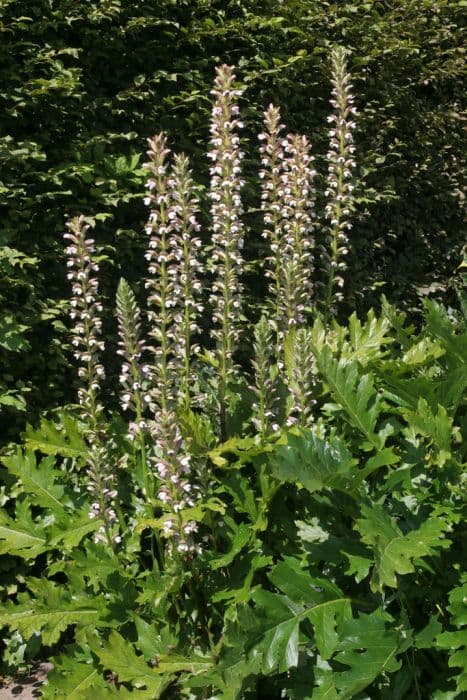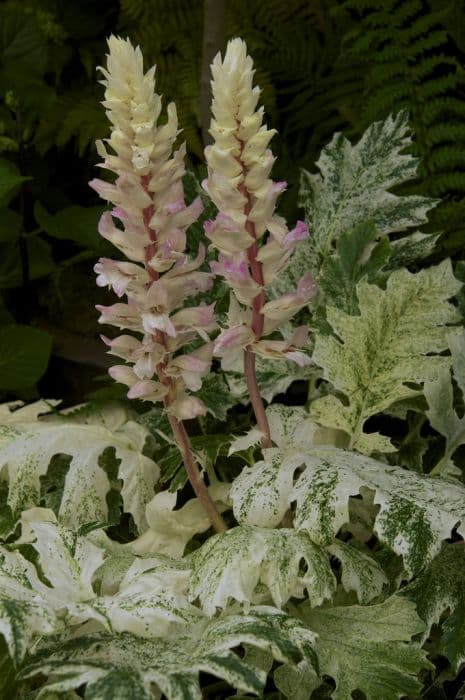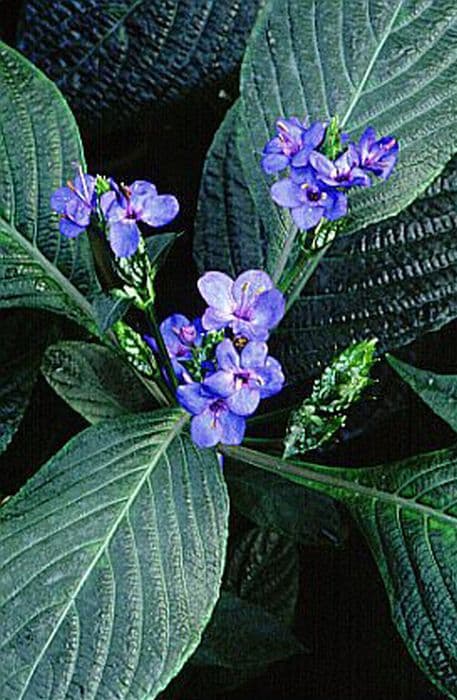Bears Breeches Acanthus mollis (Latifolius Group) 'Rue Ledan'
ABOUT
The plant known as Bear's Breeches 'Rue Ledan' is recognized for its striking foliage and beautiful flowering spikes. This perennial has large, glossy, dark green leaves with deeply cut fingers that create an attractive, architectural mound of foliage. Each leaf is broad and can be quite imposing, bringing a lush and tropical feel to a garden space. In summer, 'Rue Ledan' sends up tall spires of delicate white flowers, each adorned with a unique purple-tinged calyx, looking almost like a hooded cloak surrounding the bloom. These flowers are arranged in a dense, vertical raceme, prominently standing out above the foliage to great visual effect. Overall, the plant presents as a robust and ornamental feature, offering both dramatic foliage and eye-catching floral displays.
About this plant
 Names
NamesSynonyms
Bear's Breeches, Grecian Pattern Plant, Oyster Plant, Sea Dock.
Common names
Acanthus latifolius, Acanthus longifolius, Acanthus lusitanicus, Acanthus mollis subsp. latifolius, Acanthus mollis var. latifolius.
 Toxicity
ToxicityTo humans
Bear's breech is not considered highly toxic to humans. However, some parts of the plant, especially the leaves, contain small amounts of saponins and other compounds that can cause irritation when handled or ingested. If ingested, Bear's breech may cause gastrointestinal symptoms such as nausea, vomiting, or diarrhea. Contact with the skin can sometimes result in dermatitis or an allergic reaction. It is advisable to handle this plant with care and avoid ingesting any part of it.
To pets
Bear's breech is not typically known for being highly toxic to pets. Nonetheless, as with humans, the plant does contain saponins and other compounds that could potentially cause mild gastrointestinal upset, including vomiting or diarrhea, if ingested by pets. It is always best to keep an eye on your pet and prevent them from chewing on or ingesting this plant. If any part of the plant is consumed by a pet and symptoms develop, it is recommended to consult with a veterinarian.
 Characteristics
CharacteristicsLife cycle
Perennials
Foliage type
Evergreen
Color of leaves
Green
Flower color
White
Height
3-4 feet (0.91-1.22 meters)
Spread
2-3 feet (0.61-0.91 meters)
Plant type
Herb
Hardiness zones
7
Native area
Mediterranean
Benefits
 General Benefits
General Benefits- Ornamental Value: Acanthus mollis 'Rue Ledan', commonly known as Bear's Breeches, has striking foliage and beautiful flower spikes that add aesthetic beauty to gardens and landscapes.
- Drought Tolerance: Once established, it is relatively drought-resistant, making it suitable for gardens in drier climates or for water-wise gardening practices.
- Low Maintenance: This plant requires minimal care once it is established, making it ideal for gardeners who prefer lower maintenance landscaping options.
- Architectural Structure: The bold leaves and tall flower stalks of Bear's Breeches provide strong architectural interest in garden design, particularly useful in creating focal points or borders.
- Wildlife Attraction: The flowers can attract bees and other pollinators to the garden, which is beneficial for plant pollination and supporting biodiversity.
- Shade Tolerance: It can thrive in partial shade, making it a versatile plant for different garden situations, especially under canopies of larger trees or on the north side of buildings.
- Soil Adaptability: Bear's Breeches can adapt to a variety of soil types, although it prefers well-drained soil, it can tolerate clay or poorer soils to a certain extent.
- Long Bloom Season: The flowering period extends through the summer months, providing long-lasting visual interest in the landscape.
- Herbaceous Perennial: As a perennial, it will come back year after year, providing a reliable and consistent presence in the garden.
 Medical Properties
Medical PropertiesThis plant is not used for medical purposes.
 Air-purifying Qualities
Air-purifying QualitiesThis plant is not specifically known for air purifying qualities.
 Other Uses
Other Uses- Acanthus mollis is used as a model in architectural elements, specifically in Corinthian capitals, where the leaves are carved into stone or wood for decorative purposes in buildings and monuments.
- The spiky flowers of the Bear's breeches can be used in dried flower arrangements, providing an interesting texture and shape that lasts long after the plant has stopped blooming.
- In ornamental gardening, Bear's breeches is sometimes used as a dramatic backdrop for other plants due to its large foliage and striking flower spikes.
- Artists and illustrators may use the plant as a subject in botanical illustrations, admiring its bold structure and distinct leaf pattern.
- Bear's breeches can be used in crafting, where its striking leaves are sometimes printed onto fabric or paper to create unique patterns.
- The leaves of Acanthus mollis can be used as natural stencils for spray painting or applying patterns onto various surfaces.
- The texture and pattern of Bear's breeches' leaves are sometimes replicated in metalwork for decorative gates and grilles, showcasing ornate designs.
- In the creation of eco-friendly burial products, such as biodegradable coffins, the leaves and motifs of Bear's breeches have been used to decorate the exteriors.
- The plant's aesthetic has inspired patterns in interior design, with its leaf motif appearing on wallpaper, textiles, and home accessories.
- As a teaching tool in botany and horticulture, Bear's breeches may be used to demonstrate plant structure and leaf morphology to students.
Interesting Facts
 Feng Shui
Feng ShuiThe Bear's Breech is not used in Feng Shui practice.
 Zodiac Sign Compitability
Zodiac Sign CompitabilityThe Bear's Breech is not used in astrology practice.
 Plant Symbolism
Plant Symbolism- Artistic Inspiration: Acanthus mollis, commonly known as Bear's Breeches, often symbolizes an appreciation for art and creativity. Its use in classical Corinthian column capitals reflects a long history of inspiring artists and architects.
- Endurance: The plant's ability to grow in tough conditions and its perennial nature symbolize endurance and the ability to withstand hardships.
- Pain: With its thorny leaves, Bear's Breeches can also represent pain or difficulty. Historically, it was sometimes used in funerary art to symbolize the pain of loss or the difficulties of life.
 Water
WaterBear's Breeches should be watered deeply, allowing the soil to dry out slightly between waterings. During active growth in spring and summer, typically water every 7 to 10 days, but adjust based on rainfall and temperature. Ensure the plant receives about 1 to 1.5 inches of water each time, translating to about 0.6 to 0.9 gallons for an established plant in well-draining soil. In winter, water less frequently, only when the soil is dry several inches below the surface.
 Light
LightBear's Breeches thrives in partial shade to full sun. The best spot for this plant is one where it can receive morning sunlight and afternoon shade, particularly in hot climates. A spot with dappled sunlight throughout the day is also suitable, as it enjoys bright but indirect light.
 Temperature
TemperatureBear's Breeches prefer a temperate climate and can tolerate a wide range of temperatures. They can survive minimum temperatures down to approximately 15°F and maximum temperatures well into the high 90s°F. Ideally, maintain an environment where the temperature stays between 50°F and 80°F for optimal growth.
 Pruning
PruningPruning Bear's Breeches enhances its appearance and health, controlling size and removing spent flower spikes and damaged foliage. Prune in late winter or early spring before new growth begins. Deadhead flowers after blooming to encourage a second flush of flowers, and remove any damaged or diseased leaves as needed. The best time for major pruning is immediately after the plant finishes flowering.
 Cleaning
CleaningAs needed
 Soil
SoilBear's breeches prefer well-draining soil enriched with organic matter. A soil mix consisting of two parts loam, one part sand or perlite, and one part compost or well-rotted manure is ideal. Aim for a soil pH between 6.0 and 7.5 for optimal growth.
 Repotting
RepottingBear's breeches do not require frequent repotting and can typically be repotted every 2 to 3 years. They have a deep root system, so choose a deep container when repotting.
 Humidity & Misting
Humidity & MistingBear's breeches are adaptable to a range of humidity levels but prefer average to drier conditions. They do not require high humidity environments to thrive.
 Suitable locations
Suitable locationsIndoor
Provide bright indirect light, and water when topsoil is dry.
Outdoor
Plant in partial shade, in well-draining soil, and water moderately.
Hardiness zone
7-10 USDA
 Life cycle
Life cycleAcanthus mollis 'Rue Ledan', commonly known as Bear's Breeches, begins its life cycle with seed germination, typically in spring when soil temperatures warm. Following germination, seedlings emerge and establish a rosette of deep green, glossy leaves. As the plant matures, it enters a vegetative stage where it further develops its foliage and root system. Usually in the second year, Bear's Breeches produces tall flower spikes adorned with white flowers accented by purple bracts throughout the summer. After pollination, seeds develop and are eventually dispersed, completing the reproductive cycle. During winter in colder climates, the plant may die back to the ground but will resprout from its perennial rootstock the following spring.
 Propogation
PropogationPropogation time
Spring-Early Summer
Propogation: The most popular method to propagate Acanthus mollis 'Rue Ledan', commonly known as Bear's Breeches, is by root division. This process is best carried out in the early spring or fall. Carefully dig out the plant, trying to keep the root ball intact. Using a sharp spade or knife, divide the root clump into several sections, making sure each section has both roots and shoots. Replant the divisions immediately, spacing them about 18 inches to 2 feet apart (approximately 45 to 60 centimeters), at the same depth they were growing previously. Water the new plantings thoroughly to help establish them. Root division is an effective way of maintaining plant health and vigor while increasing your stock of Bear's Breeches.
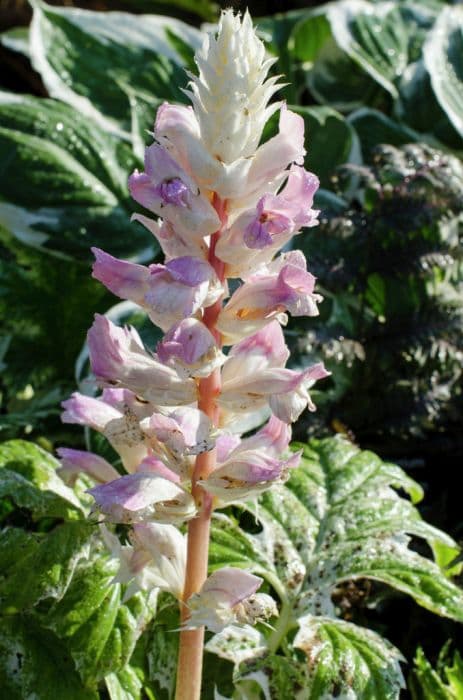
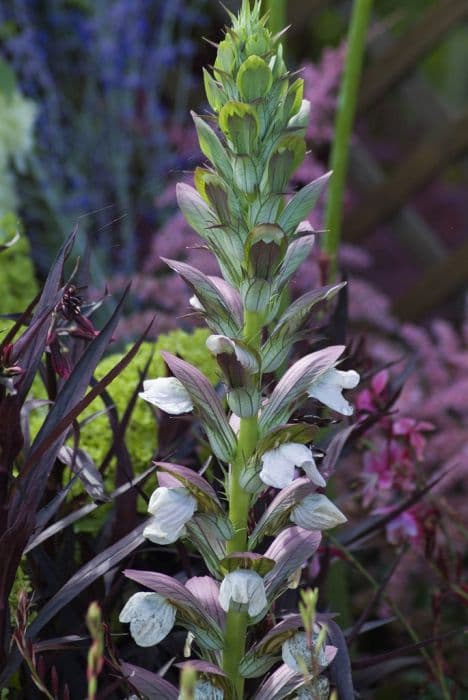



![Black-eyed Susan [Sunny Suzy Red-Orange]](/_next/image?url=https%3A%2F%2Fplants-admin.emdemapps.com%2Fimages%2Fplants%2F%2Fimages%2F607ea5891ee3f.jpg&w=640&q=75)
